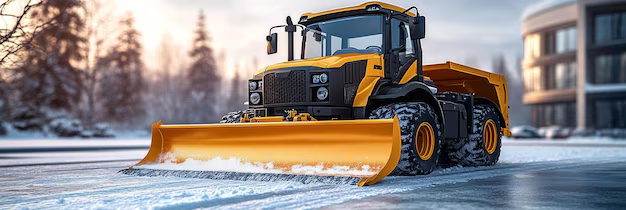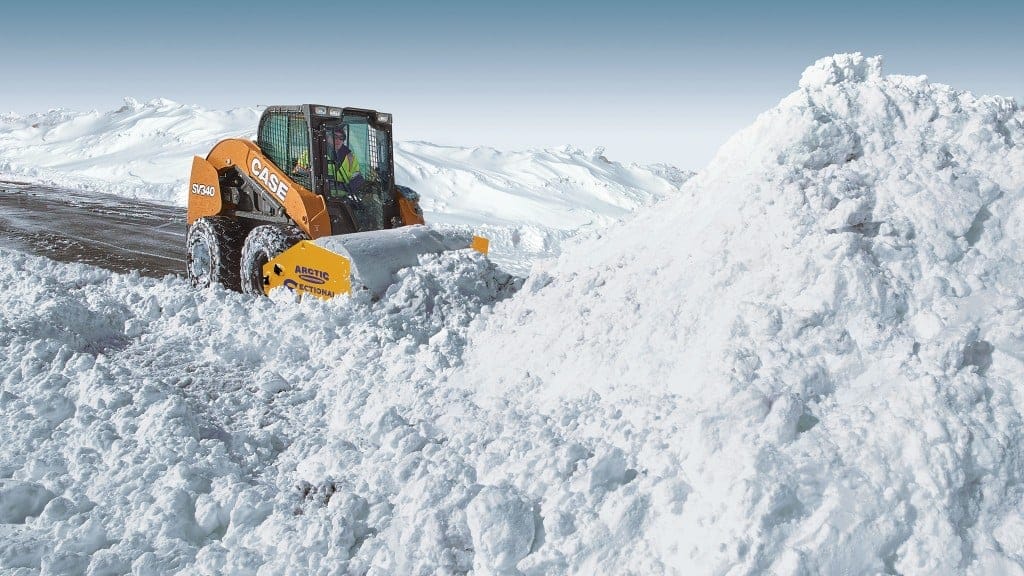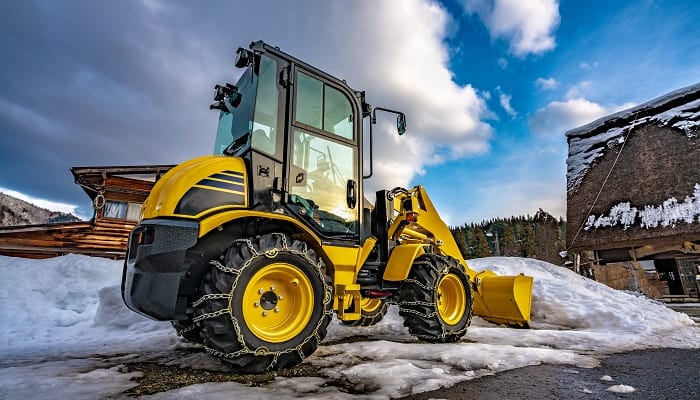Winter poses extreme challenges for snow removal equipment, with cold temperatures and heavy workloads straining even the toughest machines. Proper preparation is essential to prevent breakdowns, costly repairs, and inefficiencies during peak operations. This guide offers practical maintenance tips and winterizing strategies to keep your machinery in top condition. By implementing these measures, you’ll improve performance, enhance operator safety, and extend equipment lifespan, ensuring reliable operation throughout the harshest winter conditions.
Table of Contents

A Comprehensive Winter Preparation Checklist.
This winter preparation checklist provides a comprehensive guide to preparing your snow removal equipment for winter, focusing on the most critical maintenance areas to ensure reliable performance. While it doesn’t guarantee 100% coverage, it represents a well-researched approach addressing at least 95% of potential issues. Every day presents opportunities to refine your knowledge and practices, but by following these key steps, you’ll significantly enhance your equipment’s efficiency, safety, and durability during the demanding winter season.
1. Inspect the Machine.
Prior to the onset of winter, it is essential to conduct a comprehensive inspection of your snow removal equipment. Particular attention should be given to commonly used machinery such as plows, loaders, and snowblowers. Key components of your snow removal equipment to evaluate include:
- Blades: Carefully inspect the cutting edges of plows for signs of wear or damage and replace them if necessary to maintain optimal performance.
- Tracks/Tires: Assess the condition of tracks and tires, checking for any damage or wear, to ensure they are in proper working order and provide reliable traction.
- Hoses: Examine all hoses, particularly those in hydraulic systems, for cracks, leaks, or other signs of deterioration, addressing any issues promptly.
- Attachments: Test all plow attachments, including scrapers, blades, and buckets, to verify secure connections and proper functionality before use.
2. Check Hydraulic System.
The hydraulic system serves as a vital component of snow removal equipment, requiring meticulous preparation to ensure optimal functionality. Begin by conducting a thorough inspection of the system to identify any leaks or damage to hoses. Regularly check and maintain hydraulic fluid levels, replenishing as needed. For enhanced performance in winter conditions, consider draining and refilling the system with winter-grade hydraulic fluid. Additionally, treat hydraulic hoses to prevent cracking caused by exposure to cold temperatures, thereby ensuring reliability during demanding operations.
3. Check for Proper Lubrication.
Ensuring proper lubrication is critical for maintaining smooth and efficient operation of equipment during cold weather. Use lubricants specifically formulated for low-temperature conditions on all moving components. Follow the manufacturer’s recommendations to grease all fittings and pivot points thoroughly. Particular attention should be given to vertical pins and wear points on v-plows to prevent excessive friction and ensure optimal performance.
4. Battery Maintenance.
Cold weather poses significant challenges to battery performance, necessitating proactive measures to ensure reliability. It is essential to test the battery’s charge level and replace it if found inadequate. Regularly clean the battery terminals to prevent corrosion, which can hinder performance. Additionally, utilizing a battery tender during periods of inactivity is recommended to maintain an optimal charge and extend the battery’s lifespan.
5. Check Cooling System.
The cooling system remains a vital component of snow removal equipment, even during winter operations. It is essential to:
- Verify antifreeze levels and concentration to prevent freezing and ensure proper engine protection.
- Inspect the radiator thoroughly for any signs of leaks or damage that could compromise performance.
- Confirm that the thermostat is functioning correctly to maintain optimal engine temperature under cold operating conditions.

6. Check Tires and Tracks.
Maintaining proper traction is essential for ensuring safe and efficient snow removal operations. For tires, regularly check the pressure, inspect for signs of wear, and evaluate the need for winter-specific tires. For tracks, confirm correct tension and thoroughly examine them for damage or excessive wear. Promptly replace any worn or compromised components to maintain optimal performance and operational safety.
7. Check Lights and Electronics.
Ensuring visibility and control is paramount during winter operations. Conduct a thorough inspection and testing of all lighting systems, including headlights, taillights, and warning lights, to guarantee proper functionality. Verify that heating and defrosting systems are operational to maintain comfort and safety in low temperatures. Examine and clean all electrical connections, applying dielectric grease to protect against corrosion. Lastly, ensure that all control panels and computerized systems are in optimal working condition to facilitate seamless operation.
Adhering to this comprehensive checklist will substantially enhance the reliability and efficiency of your snow removal equipment, ensuring optimal preparedness for the demanding conditions of winter operations.
Winter-Specific Equipment Modifications for Your Snow Removal Equipment.
Proper preparation of your snow removal equipment for winter operations is crucial to ensure both efficiency and safety throughout the season. As the cold months approach, taking the time to assess, upgrade, and modify your machinery can prevent breakdowns, enhance performance, and ensure a smooth operation even in the harshest conditions. To help you get started, here are some key winter-specific equipment modifications and adjustments you should consider implementing to keep your equipment ready for the challenges of winter:
Enhance Traction with Snow Chains.
Snow chains are an indispensable tool for improving traction on icy and snow-covered surfaces during winter operations. They play a critical role in ensuring safety and operational efficiency. Here are the key considerations:
- Design: Snow chains provide a textured surface that grips into snow and ice, allowing tires to maintain a secure hold on slippery roads.
- Material: Choose high-quality chains constructed from robust, durable steel to endure the demanding conditions of severe winter environments.
- Installation: Modern snow chains are engineered for ease of use, enabling quick and straightforward installation without the need to reposition the vehicle or endure extended exposure to cold conditions.
- Vehicle Compatibility: Select chains that are specifically designed to fit your vehicle model and tire dimensions to ensure optimal performance and safety.

Use Specialized Blades for Enhanced Snow Removal Efficiency.
Upgrading the blades on your snowplow can significantly enhance performance and productivity in various snow-clearing scenarios. Consider the following blade types:
- Carbide Blades: Featuring a carbide insert brazed to a steel face, these blades offer exceptional wear resistance and sharpness, making them ideal for efficiently clearing ice and deep snow.
- Steel Blades: As the most common and cost-effective option, steel blades are highly effective for removing packed snow without the need for additional chemicals or salt.
- Rubber Blades: Designed to be flexible and surface-friendly, rubber blades are well-suited for clearing light, fluffy snow on decorative pavements without causing damage.
- Polyurethane Blades: These blades strike a balance between durability and minimal surface impact, reducing vibrations and noise while ensuring efficient snow removal.
Install Cab Heaters or Weather Shields to Enhance Operator Comfort.
Maintaining operator comfort is vital for ensuring efficiency and safety during prolonged winter operations. Consider the following features to optimize working conditions:
- Heated Cabs: Equip your machinery with heated cabs to provide warmth in cold environments. Select cabs with durable tempered windows and reliable climate control systems to ensure visibility remains unobstructed during operation.
- Soundproofing: Invest in soundproof cabs to minimize noise exposure, reducing fatigue and enhancing focus during extended shifts.
- Adjustable Seating: Provide cabs with ergonomic, adjustable seats to ensure optimal posture and comfort for operators during long working hours.
- Audio Systems: Optimizing the audio-systems in your cabs comes with effective communication between operators and team members outside the cab, ensuring smooth coordination and task execution. They also provide entertainment to keep operators motivated and focused during demanding shifts, supporting morale and productivity
Additional Modifications to Consider for your snow removal equipment.
- Salt and Crushed Stone Spreaders: These attachments are highly effective for improving traction and accelerating snow melting following plowing operations.
- Traction Tracks: Vital for maintaining grip in conditions with moderate to heavy snowfall, these tracks are particularly advantageous in confined spaces such as sidewalks, where maneuverability is critical.
- Directional Hydraulic Snow Shovels: Designed to enable operators to direct snow to specific areas, these shovels enhance operational efficiency and adaptability, making them an invaluable addition for diverse snow removal tasks.
By incorporating these winter-specific modifications, you can enhance the readiness of your snow removal equipment to perform efficiently and safely under the most severe winter conditions. Consistent maintenance and monitoring of these adjustments throughout the winter season will ensure uninterrupted and effective operations.
Snow Removal Equipment Maintenance & Off-Season Storage Tips.
Proper storage and maintenance of your snow removal equipment during the off-season are critical to preserving its longevity and ensuring peak performance when winter arrives. Below are key recommendations for storing your equipment and maintaining it during periods of inactivity:

- Secure Indoor Storage: Store your snow removal equipment in a dry, sheltered environment, ideally on a concrete surface. This approach safeguards the machinery from exposure to harsh elements such as rain, snow, and UV rays, which can deteriorate paint, compromise electronic components, and impact hydraulic systems. Avoid using tarps as coverings, as they may trap moisture and heat, leading to potential damage over time.
- Cleaning and Rust Prevention: Prior to storage, it is essential to thoroughly clean your equipment to eliminate salt, dirt, and other corrosive substances. Utilize a garden hose to effectively remove debris, ensuring all areas are clean and free of contaminants. Before placing the equipment into storage, ensure it is completely dry to prevent moisture-related damage. To protect exposed metal components, apply rust inhibitors and protective coatings, safeguarding against corrosion during periods of inactivity.
- Fluid Management: Ensure all hydraulic fluids and oils are at their recommended maximum levels to prevent air from infiltrating the system, which could compromise performance and reliability. For gas-powered equipment, thoroughly drain the fuel to avoid the formation of gum deposits within the fuel system, ensuring smooth and efficient operation during use.
- Battery Care: To preserve the charge and extend the lifespan of batteries, remove them from power tools and store them in a cool, dry environment. For larger equipment, utilize a trickle charger to maintain optimal battery health during prolonged periods of inactivity.
- Position Equipment Properly: To ensure the longevity and reliability of hydraulic systems, it is essential to store equipment correctly. For straight blade systems, fully angle the blade to shield pistons from potential corrosion. Additionally, apply a protective layer of spray grease to exposed cylinder rods to enhance resistance against environmental damage.
Extreme Cold Start-Up and Shut-Down Procedures for your Heavy Equipment.
Start-Up in Extreme Cold.
- Pre-heating: Utilize block heaters or other cold-weather starting devices to pre-warm the engine, ensuring smoother startups and reducing strain on components.
- Warm-up Period: Allow the equipment to idle until it reaches its optimal operating temperature before beginning any tasks. This practice enhances performance and protects critical systems from damage caused by sudden operation in cold conditions.
- Hydraulic Warm-up: Engage the hydraulic system briefly to circulate warm fluid throughout, ensuring smooth operation and preventing damage to components during initial use.
- Fuel Quality: Opt for high-quality winter diesel fuel, supplemented with suitable fuel conditioners, to enhance performance and prevent fuel-related issues in freezing temperatures.
Shut Down in Extreme Cold.
- Gradual Engine Cool-Down: Allow the engine to idle for several minutes before shutting it down to minimize the risk of thermal shock and protect internal components.
- Fuel System Maintenance: Maintain full fuel tanks to reduce the likelihood of condensation forming, which can compromise fuel quality and system performance.
- Battery Protection: Verify that all batteries are fully charged to prevent freezing and ensure reliable operation during cold conditions.
- DEF System Management: For equipment equipped with Diesel Exhaust Fluid (DEF) systems, allow the DEF pump to complete its cycle and evacuate fluid from the lines to avoid freezing-related issues.
Idle Period Maintenance For your Snow Removal equipment.
For equipment that will remain inactive for extended periods during the winter season, the following measures are recommended to ensure its longevity and optimal performance:
- Start the machine at least once a month, preferably when temperatures are above freezing, to maintain system integrity.
- Briefly operate the hydraulic systems to ensure proper circulation of fluids.
- Refrain from starting the machinery in extremely cold conditions to avoid potential damage to sensitive components.
- Conduct regular inspections to identify and remove any ice or snow accumulation in critical areas such as the exhaust, intake, and control systems.
By following the storage and maintenance practices outlined in this article, you can effectively preserve the condition of your snow removal equipment during the off-season. This approach ensures that your machinery remains in optimal working order and is fully prepared to perform efficiently when winter conditions resume.
Benefits of Preparing Your Equipment for Winter
Winter presents challenges for snow removal operations, with equipment like snowplows and spreaders crucial for maintaining safety and accessibility. Harsh conditions can strain machinery, making preventive maintenance essential to ensure reliability, durability, and peak performance. Some of the benefits that come with properly preparing your equipment includes:
- Minimize Costly Breakdowns: Preparing snow removal equipment before winter helps prevent unexpected malfunctions that can disrupt operations.
- Extend Equipment Lifespan: Proper maintenance and preparation go beyond addressing immediate problems—they play a vital role in prolonging the life of your snow removal machinery. By tackling minor wear and tear early, you can prevent more significant damage, ensuring your equipment remains functional for longer.
- Reduce Accident Risks: Properly maintained snow removal equipment plays a vital role in ensuring operator safety. Reliable brakes, responsive steering systems, and well-functioning critical components minimize the likelihood of accidents, especially in challenging conditions like poor visibility and slippery surfaces. By keeping your machinery in top condition, you create a safer work environment and reduce the hazards associated with snow removal tasks.
- Enhance Operator Comfort: Ensuring operator comfort during winter is essential for both safety and efficiency. Well-maintained comfort systems, such as functional cabin heating, help reduce operator fatigue in harsh conditions, leading to improved focus and safer operations.
- Increase Efficiency: Well-maintained snow removal equipment performs optimally, allowing for faster and more effective snow clearing even in harsh winter conditions. This ensures roads, parking lots, and pedestrian areas remain safe and accessible with minimal delays.
Additionally, efficient operation reduces fuel consumption and minimizes wear and tear on the machinery, saving time and operational costs.
Conclusion.
By properly preparing and maintaining your snow removal equipment for winter, you can minimize costly breakdowns, enhance operator safety, and ensure efficient operations. Implementing these strategies not only improves equipment reliability and performance but also extends its lifespan, providing long-term value. Stay proactive with these maintenance practices to tackle winter’s toughest challenges effectively and keep your snow removal operations running smoothly throughout the season.

Ningo, founder of Big Machines Today, is a passionate writer and content creator specializing in heavy-duty machinery. Focused on delivering industry insights and trends, Ningo crafts engaging content for professionals. Open to free collaborations on blogs or social media articles, Ningo invites you to connect and explore the Big Machines Today Blog for valuable updates.












